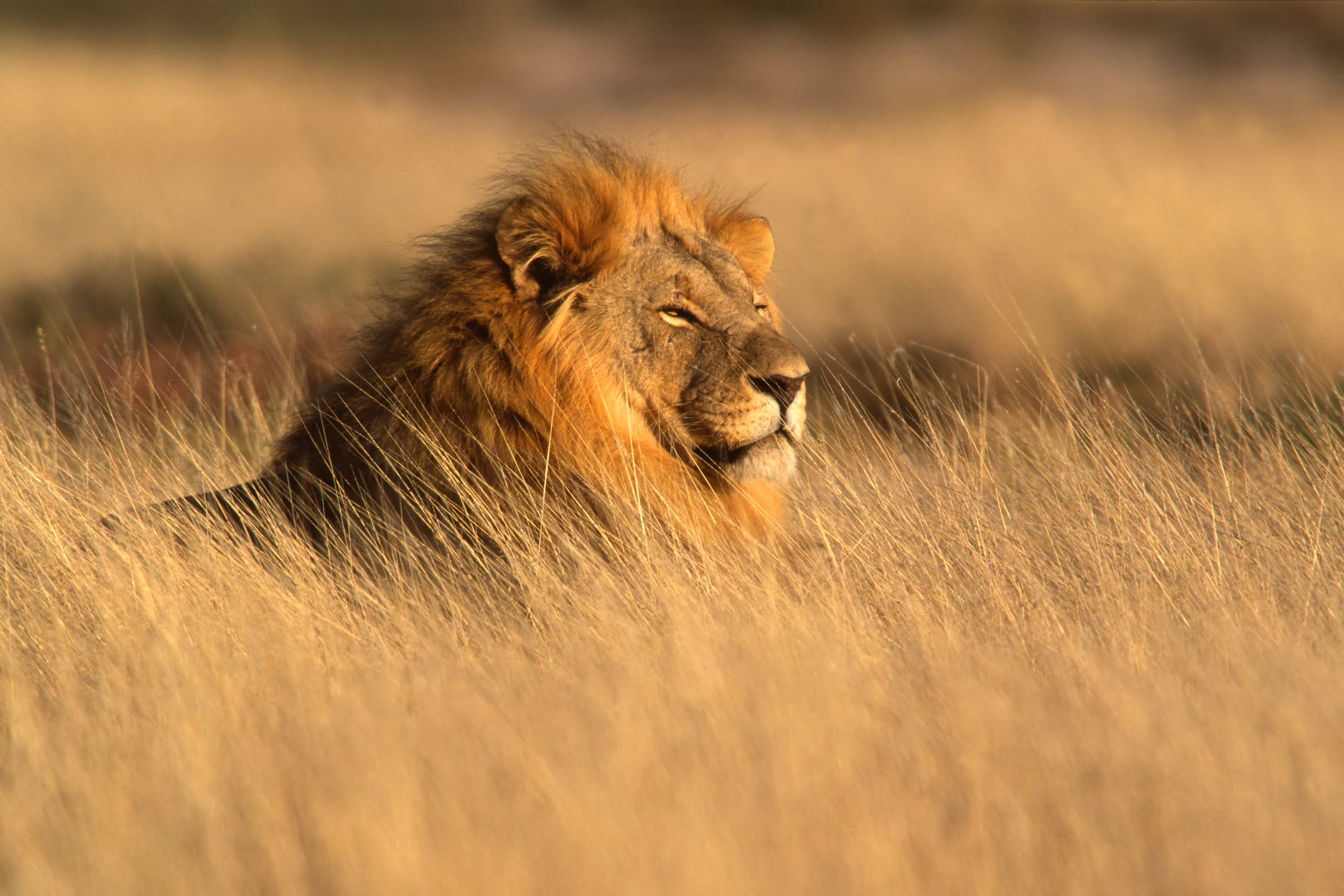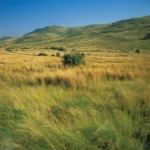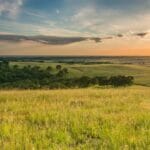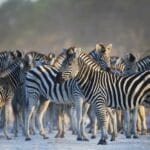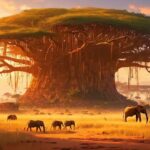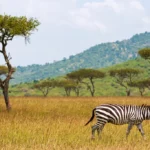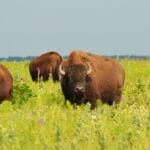Picture this: A vast, grassy plain that stretches as far as the eye can see, dotted with trees and teeming with animals. That’s a savanna, a vibrant ecosystem that’s home to some of the most amazing creatures on Earth. From the wide-open plains of Africa to the tropical grasslands of South America, savannas are found all over the world, and each one is unique and fascinating.
Facts About The Savanna
Picture this: a vast, sun-drenched grassland dotted with clusters of majestic trees. Welcome to the captivating realm of the savanna, a land of incredible diversity and ecological wonders.
A Symbiotic Mosaic
The savanna is not just a flat grassland. It’s a mosaic of different habitats, where towering forests meet open grasslands. This unique ecosystem supports a symphony of life, from the gentle giants of the elephant family to the deadly black mamba, the world’s most venomous snake.
A Bustling Metropolis of Wildlife
Imagine a place where the largest land dweller, the elephant, grazes alongside its tiny companion, the pygmy shrew. Predators like lions, hyenas, and leopards prowl the savanna, while herbivores like zebras, wildebeest, and giraffes roam in herds, creating a vibrant tapestry of life.
The Rhythm of the Seasons
Just like us humans, the savanna has its own rhythm. During the wet season, grasses sprout and thrive, providing a feast for herbivores. As the dry season approaches, lightning strikes ignite fires that sweep across the landscape, rejuvenating the vegetation and resetting the cycle of life.
Nature’s Giants
One of the most iconic symbols of the savanna is the baobab tree. Its gigantic trunk resembles a massive bottle, making it an unforgettable landmark. Acacia trees, with their distinctive flat tops, offer shade and shelter to the savanna’s denizens.
Global Wanderers
The savanna is not confined to Africa. It roams across continents, painting vibrant hues in Australia, India, South America, and Thailand. Each region boasts its own unique blend of flora and fauna, making the savanna a truly global phenomenon.
Did you know that plants in the savanna can survive in the harsh conditions? It’s fascinating to learn about the unique adaptations they’ve developed.
Speaking of fascinating, have you ever wondered what animals live in the savanna? Here’s a glimpse into their extraordinary lives and the interconnected ecosystem they thrive in.
Let’s not forget the majestic lions! Discover what do lions eat in the savanna and uncover their hunting techniques and dietary preferences.
In what regions of the world are savannas found?
Savannas, those picturesque ecosystems with their scattered trees and lush grassy ground, aren’t just confined to one corner of the globe. They’ve made their home in various regions, each with its unique flavors and ecological wonders.
Imagine a vast African plain, the sun casting a golden glow over the iconic Serengeti and Masai Mara savannas. These grassy expanses are home to a dazzling array of wildlife, from lanky giraffes to thundering herds of zebras and wildebeest.
Cross the Atlantic to South America, where the sun-kissed “pampas” and “llanos” stretch across Argentina, Brazil, and Venezuela. These savannas are like a symphony of colors, with grasses rippling like green waves and wildflowers painting vibrant hues across the landscape.
Australia’s vast savannas, found in the Kimberley region and the Northern Territory, are a testament to the continent’s natural diversity. From towering termite mounds to ancient rock formations, these grasslands offer a glimpse into a land where nature reigns supreme.
India’s central and southern regions boast the open spaces of “maidans,” savannas that provide sustenance to a rich array of plant and animal life. And even the island nation of Madagascar has its share of savannas, where the elusive fossa and the wide-eyed aye-aye roam freely.
Savannas are more than just grasslands; they’re vibrant ecosystems that support an incredible array of life. Understanding their distribution helps us appreciate their ecological significance and the need to preserve these precious biomes for generations to come.
What factors contribute to the savannas unique biodiversity?
Imagine a place where majestic elephants roam amidst vast plains of golden grass, while elusive cheetahs chase their prey through a tapestry of life that’s teeming with diversity. That’s the savanna, an ecosystem that’s a symphony of factors harmoniously creating a vibrant dance of nature.
Climate and Rainfall Patterns: A Game of Wet and Dry
The savanna’s unique climate dances to the rhythm of seasons. The wet season paints the landscape with lush, emerald green carpets as abundant rain nourishes the grasses. But when the dry season sets in, these grasses sway to a golden hue, inviting herbivores to graze their hearts out. This seasonal symphony creates a diverse mosaic that’s a haven for a wide range of creatures.
Fire and Herbivory: A Balancing Act of Nature
Fire, a force of nature, plays a pivotal role in shaping the savanna’s landscape. Whether it’s sparked by lightning or human hands, these blazes sweep through the grasslands like cleansing flames. They clear away old growth, making way for new beginnings.
Herbivores, like zebras and elephants, are the savanna’s gardeners. Their grazing habits keep the grasses from getting too tall and dense. This creates a patchwork of grass heights, offering dining options for herbivores of all shapes and sizes.
Nutrient Cycling: The Earth’s Nutrient Symphony
The savanna’s nutrient cycle is a masterpiece of nature’s symphony. During the wet season, heavy rains wash essential nutrients into the soil, like a nourishing elixir for the plants. As the dry season takes hold, the vegetation dries up, releasing these nutrients back into the soil through decomposition. This nutrient-rich earth fuels a diverse array of plant life, which in turn attracts a vibrant chorus of animal species.
Conclusion: A Tapestry of Life, A Symphony of Factors
The savanna’s biodiversity is a breathtaking symphony, composed by the harmonious interplay of climate, fire, herbivory, and nutrient cycling. These factors weave together a complex ecosystem that harbors a remarkable diversity of life. It’s a testament to the intricate web of relationships that sustain our planet’s beautiful ecosystems.
Key Takeaways:
- The savanna’s seasonal climate, with its wet and dry phases, creates a tapestry of habitats.
- Fire and herbivory work hand in hand to maintain the open savanna landscape and prevent forest invasion.
- The savanna’s unique nutrient cycling process ensures the availability of nutrients throughout the year.
- These factors combine to support an astonishing array of plant and animal species, contributing to the savanna’s exceptional biodiversity.
How do natural events like fires impact savanna ecosystems?
Fires are like Mother Nature’s reset button for savannas. They’re a natural part of these grasslands, and they play a big role in keeping them healthy.
When a fire burns through a savanna, it does more than just scorch the grass. It actually releases nutrients back into the soil, making it more fertile for plants to grow. It also helps keep the trees and shrubs in check, so that the grasses can have more sunlight and space to thrive.
But here’s the cool part: the fire creates a patchwork of different habitats within the savanna. Some areas are burned more intensely, while others are left relatively untouched. This creates a variety of microclimates that support a wide range of plants and animals.
So, when you see a savanna on fire, don’t panic. It’s just Mother Nature doing her thing, creating a healthy and vibrant ecosystem.
Fun Fact: Savanna fires also contribute to the carbon cycle. When the grass burns, it releases carbon dioxide into the atmosphere. But don’t worry, it’s part of a natural process. And if we manage fires carefully, we can actually reduce the amount of carbon released compared to letting them burn out of control.
Table: Ecological Impacts of Fires in Savannas
| Impact | How it helps |
|---|---|
| Nutrient cycling | Releases nutrients back into the soil for plants |
| Plant diversity | Prevents trees and shrubs from taking over, allowing grasses to flourish |
| Animal diversity | Creates a variety of habitats for different animals |
| Carbon emissions | Part of the carbon cycle, but controlled burns can reduce emissions |
Key Points:
- Fires are a natural part of savanna ecosystems and play a crucial role in their health.
- Fires promote plant and animal diversity by creating a mosaic of habitats.
- Prescribed burns can help manage fire regimes and mitigate carbon emissions.
FAQ
Q1: What are the defining characteristics of a savanna?
A1: Savannas are ecosystems characterized by continuous grass cover and varying levels of tree cover. They occur primarily in the seasonally dry tropics and are known for their open canopy and tall grasses. Savannas are home to a diverse range of wildlife, including large mammals such as elephants, lions, and zebras.
Q2: In what regions of the world are savannas found?
A2: Savannas are found in Africa, South America, India, and Australia. They cover approximately 20% of the Earth’s land area and are located in regions with warm to hot climates, such as near the equator.
Q3: What factors contribute to the savanna’s unique biodiversity?
A3: Savannas have high levels of biodiversity due to their unique combination of grasslands and scattered trees. This provides habitats for a wide range of plant and animal species, including large mammals, birds, and reptiles. Additionally, the seasonal variation in rainfall leads to a variety of plant species, contributing to the ecosystem’s diversity.
Q4: How do natural events like fires impact savanna ecosystems?
A4: Fires are a natural part of savanna ecosystems, particularly in Africa. They help maintain the health and diversity of the savanna by clearing out dead vegetation, promoting new growth, and controlling the density of trees. Fires also create a mosaic of habitats, benefiting various species that rely on different stages of vegetation succession.
Q5: What threats and conservation efforts surround savanna habitats and their inhabitants?
A5: Savannas face threats such as habitat loss due to agriculture and urbanization, climate change, and overgrazing. Conservation efforts focus on protecting and managing savanna ecosystems, including establishing protected areas, promoting sustainable land use practices, and raising awareness about the importance of these unique habitats.
- Senior at What Age: Benefits & Eligibility Guide - March 29, 2025
- Unlocking Senior Benefits: How Old is a Senior? Your Complete Guide - March 29, 2025
- Master Russian Politeness:A Guide to Saying Please - March 29, 2025
